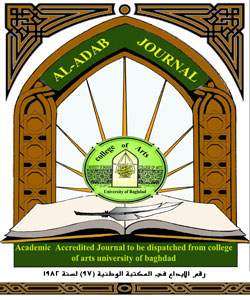Dystopian Reality in Frankenstein in Baghdad a novel by Ahmed Saadawi
DOI:
https://doi.org/10.31973/aj.v0i133.606Keywords:
Dystopia, Utopia, Terrorist, whatsitsname, violanceAbstract
Dystopian literature is important in old and modern literature. It depicts a world in which everything is imperfect, chaotic and distorted. It shows a nightmarish image yet it is true in some afflicted communities. It mainly deals with war, oppression and disastrous situations. Almost all the characteristics of dystopian literature are real in Ahmed Saadawi’s novel Frankenstein in Baghdad. These characteristics are real and tangible in the place where the events of the novel occurred. These characteristics are manifested in people’s fear from the government, the American troops and terrorism attacks. Also the unstable life that they are forced to adapt. In addition, the lack of freedom and independence create a huge gap between citizens and the government.
Baghdad was devastated by many oppressive factors like: American annoying troops, terrorists’ explosions attacks, incompetent government highly officials, and militias’ sectarian attacks. The only imaginative tool of dystopia that Saadawi use is the creation of Whatsitsname. Saadawi tries to drag his readers’ attention to a magical-realistic world. All the other incidents are real and present in everyday life in Baghdad in 2005; like the unsafe capital, the disintegration of family members, the separated limps of victims. Saadawi virtually described the dark era in Baghdad at that time. The bloodshed, the torture and massive killing was overwhelming the city.
Dystopian fiction links elements of truth that is specific to the time in which it is written in with science or imaginary elements that represent the terrifying direction we are winding to. Frankenstein in Baghdad converses this classic formula: the dystopian fundamentals of the novel are not engrained in its hypothetical and mythical elements but rather in the very real, frightening violence that Baghdad witnessed in 2005.
Downloads
References
British Library learning Dreamers and Dissenters. “Utopia” http://www.bl.uk/learning/histcitizen/21cc/utopia/utopia.html
Claeys, Gregory. Dystopia: A Natural History. Oxford University Press. Oxford 2017.
Crawley, John. & Co “Lives of Saint with Excerpts from their Writings’’ New York. August 7,1954. Nihil Obstat: John M. A. Fearns, S.T.D., Censor Librorum.http://www.marys-touch.com/Saints/more.htm
Davis, J.C. Utopia and the Ideal society: A Study of English Utopian Writing1516-1700. Cambridge University Press. London. 1981.
Demerjian, Lousia Mackag. The Age of Dystopia: One Genre, Our Fears and Our Future. Cambridge Scholarship: London. 2016.
Elaine, Ostry and Hintz Carrie. Utopian and Dystopian Writing for Children and Young Adults. Rutledge. London. 2003.
Gale, Gengage. Contemporary Literary Criticism. University of Chicago Press. Chicago. 2003.
Garner, Dwight. ‘‘Frankenstein in Baghdad,’ a Fantastical Manifestation of War’sCruelties’’Jan.22.2018https://www.nytimes.com/2018/01/22/books/review- frankenstein-in-baghdad-ahmed-saadawi.html
Gottlieb, Erika. Dystopian Fiction East and West: Universe of Terror and Trail. McGill- Queen’s University Press. London. 2001.
Lehneen, Christine. Defining Dystopia: A Genre between the Circle and the HungerGames: A Fictional Approach to Fiction. Tectum Verlag Marburg. Germany. 2016.
Levitas, Ruth. The Concept of Utopia. Peter Lang AG International Academic Publisher. Bern. 2010.
Manuel, p. Fritize and Manuel Frank. E. Utopian Thoughts in Western World. Harvard University Press. Cambridge. 1997.
Marc’hadour Germain P. “Thomas More English Humanist and Statesman”
https://www.britannica.com/biography/Thomas-More-English-humanist-and-statesman
Merriam Webster Dictionary https://www.merriam-webster.com/dictionary/utopia
Morley, Henry. A First Sketch of English literature. Cassell &Company limited.London. 1892.
Russel, Elizabeth.ed. Trans / Forming Utopia: The Small Thin Story. Vol 2.
Internationaln Academic Publisher. Bern. 2009.
Saadawi, Ahmed. Frankenstein in Baghdad. Oneworld Publications. London. 2018
Sam Metz. Fiction of Dystopian Times: Ahmed Saadawi’s “Frankenstein in Baghdad” https://lareviewofbooks.org/article/fiction-dystopian-times-ahmed-saadawis-frankenstein-baghdad 3
Downloads
Published
Issue
Section
License
Copyright and Licensing:
For all articles published in Al-Adab journal, copyright is retained by the authors. Articles are licensed under an open access Creative Commons CC BY 4.0 license, meaning that anyone may download and read the paper for free. In addition, the article may be reused and quoted provided that the original published version is cited. These conditions allow for maximum use and exposure of the work.
Reproducing Published Material from other Publishers: It is absolutely essential that authors obtain permission to reproduce any published material (figures, schemes, tables or any extract of a text) which does not fall into the public domain, or for which they do not hold the copyright. Permission should be requested by the authors from the copyrightholder (usually the Publisher, please refer to the imprint of the individual publications to identify the copyrightholder).
Permission is required for: Your own works published by other Publishers and for which you did not retain copyright.
Substantial extracts from anyones' works or a series of works.
Use of Tables, Graphs, Charts, Schemes and Artworks if they are unaltered or slightly modified.
Photographs for which you do not hold copyright.
Permission is not required for: Reconstruction of your own table with data already published elsewhere. Please notice that in this case you must cite the source of the data in the form of either "Data from..." or "Adapted from...".
Reasonably short quotes are considered fair use and therefore do not require permission.
Graphs, Charts, Schemes and Artworks that are completely redrawn by the authors and significantly changed beyond recognition do not require permission.
Obtaining Permission
In order to avoid unnecessary delays in the publication process, you should start obtaining permissions as early as possible. If in any doubt about the copyright, apply for permission. Al-Adab Journal cannot publish material from other publications without permission.
The copyright holder may give you instructions on the form of acknowledgement to be followed; otherwise follow the style: "Reproduced with permission from [author], [book/journal title]; published by [publisher], [year].' at the end of the caption of the Table, Figure or Scheme.












